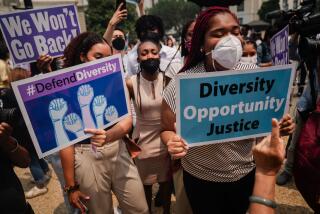A Simple Case of Defining Whatâs Fair
NEW YORK â Before it almost reached the U.S. Supreme Court last week, the Piscataway, N.J., school boardâs 1989 decision to retain a black female teacher and lay off a white female seemed like an easy choice in a tough situation. The board was forced to let one go. The facts it faced were stranger than fiction: The two had equal seniority, equal qualifications and taught in the same high school business program. With no other blacks among the 10 business teachers, the board chose to diversify the programâs faculty in a racially mixed school.
For proponents of diversity, like me, the boardâs choice presented a rare instance of uncomplicated precision in the application of principles to ideals. Diversity debates often bog down over messy questions of meritocracy and role modeling. Here was equitability. Here was the prospect of exposing impressionable teens to rough-and-tumble business transactions through the still-unlikely eyes of a black woman. However, on these mythical facts, the white teacher, Sharon Taxman, claimed an unfair trammeling of her rights, winning in two lower courts before the dispute went to the Supreme Court to rule on diversityâs essence.
But wait. Why, then, did a coalition of civil-rights groups led by the Black Leadership Forum suddenly step from the wings to buy off the white teacher with a monetary settlement? And why would Taxman, a victim of liberal excess, allow herself to be bought out? Buying out your rivals is a â90s kind of thing, which is why, for example, the Big Six accounting firms will soon be the Big Four. Has the civil-rights community simply joined the times?
Though it is common for lawyers, even civil-rights lawyers, to put a price on a case and thereby settle a cause, that does not fully explain the anguished wisdom of the groupâs difficult choice.
As a legal matter, the Piscataway case was far more complicated than it seemed. Taxmanâs claims were based on a federal statute, Title VII, whose broad reach meant that an unfavorable ruling could threaten the stability of a variety of affirmative-action plans, even those that bore no resemblance to the boardâs. A slim majority of justices on this Supreme Court has signaled a willingness to alter drastically the fabric of affirmative action in education, and this case drew briefs from conservative institutions around the country urging them to do just that. The Piscataway board never imagined such implications when it laid Taxman off in 1989, however, waffling in its rationale between remedial affirmative action and diversity. These bases are legally distinct, and the boardâs failure to develop a strong case record to support one or the other further weakened its position.
As a practical matter, hard decisions in furtherance of educational diversity are typically made under more nuanced circumstances than the Solomonic crisis faced by the Piscataway board. Diversity policies entail systematic strategies to bring to the learning environment the social and demographic realities of the changing world beyond. Factors such as race, faith, ethnicity, socioeconomic class and geography will receive varying weights depending on the setting. But the methodology is never exact because all these choices involve real people. And all these people have a history.
Which brings us back to the present. Opponents of diversity and affirmative action generally, while disappointed by the lost opportunity, have ridiculed the civil-rights groupsâ decision to withdraw from the blood bath. With bellicosity, they accuse them of a cowardly retreat. Worse, they contend that the buy-out decision proves that time is up for affirmative action in America and individual ability has triumphed over racism.
But that couldnât be true, even if you believe that Americans are not beholden to their history like other people around the world, and that time offers endless opportunities to re-invent oneself.
For if all that were true, Abner Louima, the Haitian immigrant in Brooklyn, would not be recovering from injuries to his rectum and mouth when policemen taught him a lesson with a plunger. Oumar Dia, the Mauritanian immigrant executed by a skinhead at a Denver bus stop, would not be dead. Black churches throughout the South would rebuild themselves from arson. Texaco officials would only refer to jellybeans among their grandchildren. And Californiaâs students of color would again enjoy admission to the universities their parents disproportionately pay taxes for.
These beatings, lynchings, burnings and denials of access to public and private institutions have the terrible and unmistakable ring of history, because history is durable and repeatable inside us, and we are still living through it.
None of this is to suggest that we are without choices. But they are hard choices that cannot be reduced to platitudes. The Piscataway case, and affirmative action more broadly, forces a reconsideration of fairness. Children proudly proclaim that fair is fair, but the rest of us recognize that fair is what we as a society decide it should be.
Unfortunately, the norms of fairness that the Supreme Court says should govern affirmative-action doctrine assume no one should ever sacrifice anything, history is irrelevant and redress must be extremely temporary. The problem is, if a society that is already unequal begins to seek fairness under these rules, then those at the top a) wonât be expected to share; b) wonât be questioned seriously about how they got what they have, and c) wonât have to wait long to see the whole experiment end. Fairness like that tends to favor those who already have it made. Meanwhile, those who begin to take advantage of new opportunities must somehow transcend the deprivations of their past, move fast and never stumble.
Such an oversimplified notion of fairness also enables the opponents of affirmative action to co-opt its terms and the moral high ground that used to come with them. Proposition 209 proclaimed itself a âcivil-rights initiative,â seeking an end to discrimination based on race or ethnicity. Why? In the name of fairness.
Clearly, this is upside-down. And ironically, much of this confusion results from the historic effectiveness of these same civil-rights organizations in re-awakening national consciousness to the primacy of individual rights. The civil-rights movement succeeded in securing for nonwhite citizens rights enjoyed exclusively and unapologetically by whites. For the second time in the nationâs history, white supremacy was caught in a constitutional contradiction about what is fair: Yes, America confers the blessings of liberty, but with true freedoms allocated by skin color. The end result was formal equality and the revival of rights rhetoric now being used against its champions.
But the mere use of rhetoric, like advertising, does not prove somethingâs real. Of course, most of us aspire to be known more for our similarities than our differences and distinguished only by our talents. Of course, most of us would prefer a society in which pious pronouncements of colorblindness traveled quietly within us as unspoken truths. But thatâs not what we inherited or what we practice.
Instead, we have suburbs and exurbs dividing cities and inner cities from tax bases and school funding along segregated grids. We have sectors of motivated low-wage workers virtually unemployable for the jobs within reach of them and fresh college grads on Wall Street collecting six-figure bonuses at yearâs end. We have Tiger Woods and Abner Louima, a lot of firsts but many more lasts.
None of this is easy and little is fair, except that patterns marking who belongs to which fate have something to do with accident and even more with the chokehold of personal and national history.
It is the silent, nagging, often unconscious effect of this history that continues to define the need for both remedial affirmative-action efforts in the allocation of societyâs resources as well as the cultural diversity that prevents our becoming fools that time passed by. This requires a more complex notion of fairness--dependent on some sense of history, a willingness to acknowledge unearned privilege and, of course, sacrifice. The evidence of need is undeniable, and the Piscataway affair provides an occasion to rework the rules.
These are not choices easily made by judges, who are so apt to ask, âFor how long?â Simple, we tell them. Until there are no more firsts or seconds, and all the lonely tokens have long passed, leaving forgetful grandchildren to carry on.*
More to Read
Get the L.A. Times Politics newsletter
Deeply reported insights into legislation, politics and policy from Sacramento, Washington and beyond. In your inbox three times per week.
You may occasionally receive promotional content from the Los Angeles Times.










